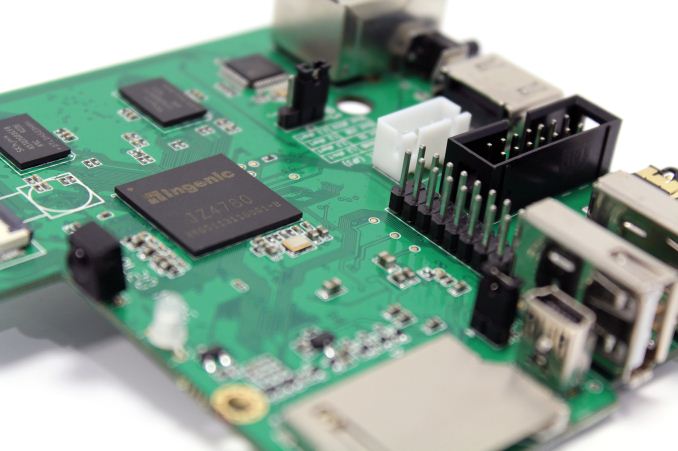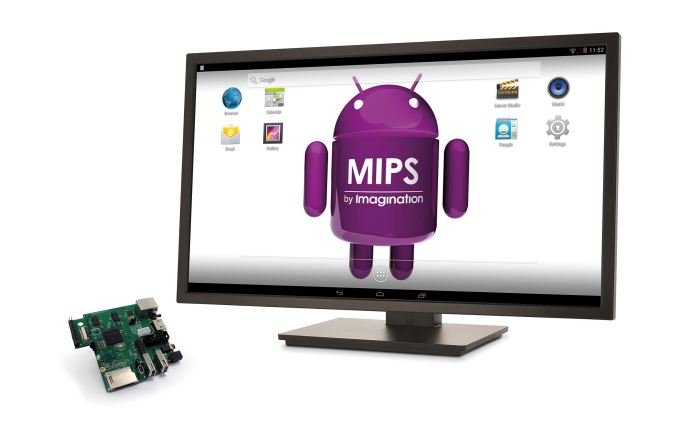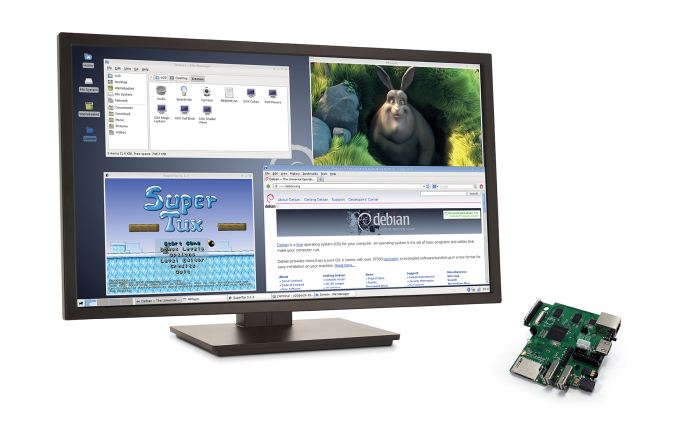Imagination Launches Creator CI20 Development Board
by Stephen Barrett on December 8, 2014 9:00 AM EST
Last week Imagination launched the Creator CI20 development board. This device is quite interesting because of the combination of architecture, features, developer support, form factor, and pricing. It also has some historical significance as it houses the first SoC to combine a MIPS CPU with PowerVR graphics. Imagination (the company behind PowerVR) purchased MIPS Technologies in February of 2013, and now the fruit of that investment can be found in silicon. That SoC is the Ingenic JZ4780. Ingenic is also known for the development of the Newton platform and XBurst CPUs.
At a high level, the easiest way to describe the CI20 is Raspberry Pi on steroids. Or perhaps this is what the Raspberry Pi could have been if redesigned two years later with about 60% more cost and a larger PCB size budget. This was clearly a target of Imagination as the CI20 contains the exact same expansion connector as the Raspberry Pi.
| Imagination Creator CI20 | Raspberry Pi Model B+ | |
| SoC | Ingenic JZ4780 | Broadcom BCM2835 |
| CPU | Dual 1.2GHz XBurst (MIPS32 instruction set) |
700 MHz ARM1176JZF-S (ARM11 family, ARMv6 instruction set) |
| GPU | PowerVR SGX 540 @ Unknown MHz | Broadcom VideoCore IV @ 250 MHz |
| Memory | 1GB DDR3 | 512MB DDR2 |
| USB | 1x USB OTG (A and Mini connectors) 1x USB Host |
4 USB 2.0 Host |
| Camera Interface | 24-pin connector (ITU-R BT.645) | 15-pin MIPI (CSI) connector |
| Video Output | HDMI 1.4a | HDMI 1.3a Composite video 3.5mm jack |
| Audio In | 3.5mm jack shared with output | via I²S interface |
| Audio Output | HDMI 3.5mm jack shared with input |
HDMI 3.5mm jack I²S interface |
| Storage | 8GB NAND 1x full SD slot 1x SD slot via expansion header |
via MicroSD |
| Network | 10/100 Ethernet 2.4GHz WiFi b/g/n + BT 4.0 (BCM4330) |
10/100 Ethernet |
| IR | Input (IRM-2638A) | - |
| Max Power Consumption | 4 Watts | 3 Watts |
| Power Connector | 5V barrel connector | MicroUSB |
| Size | Approx. 90mm x 95mm (3.54 in x 3.74 in) | 85.60 mm × 56.5 mm (3.37 in × 2.22 in) |
| Price | $65 or £50 | $35 without MPEG2 and VC1 codecs $40.60 with MPEG2 and VC1 codecs |
(Update 2/3/2015: Creator CI20 non-eval production units shipped with 8GB of NAND)
As you can see from the above table, the CI20 is in a completely different league when it comes to technical specifications. A much more powerful SoC, featuring MIPS and PowerVR, headlines the CI20, but the wealth of interfaces combined with improved storage/memory completes an impressive package for the price. Both the Raspberry Pi and the CI20 feature similar encode and decode support, except the pricing for the CI20 includes licenses to do so. Also, the CI20 supports 1080p60 decode, an upgrade over the 1080p30 of the Raspberry Pi.
For the software side of things, Imagination provides images for the CI20 of both Android Kitkat 4.4.4, Debian 7, Gentoo Linux, Yacto Sato, and Angstrom. Arch and OpenWRT are works in progress. For home media center users, there has also been some investigation running XBMC with Debian on the CI20.
I personally use XBMC on a Raspberry Pi at home. I requested a CI20 review unit from Imagination and received it this past Friday. I plan on doing some performance and power measurements on the device for a future article. Those interested in acquiring a CI20 can preorder (shipping at end of January) at the Imagination Store and enter a giveaway from Imagination.













27 Comments
View All Comments
ddriver - Tuesday, December 9, 2014 - link
I have the board and have measured it. It is powered by 5 volts, at web browsing in consumes less than 0.5 amps, H264 DH playback - bellow 1 amp, about 1.5 amps on 100% CPU load for all cores. That makes 2.5 watts for web browsing, 5 watts for HD playback and 7.5 watts during CPU torture test.100% more cores at 50% higher clock speed, the U3 only consumes 50% more power. And you'd expect it does, seeing how it is 32nm vs what... like 40nm at least for the CI20...
alexvoica - Tuesday, December 9, 2014 - link
Cool, and thanks for the info. I was highlighting how the eating for breakfast can actually be a more nuanced story. If you are looking at it from a performance point of view, then yes - ODROID-XU3 is certainly in another class.My remark was trying to attract your attention towards performance/power for entry-level boards, where MIPS (and this board) has a real advantage. For example, I've been running GeekBench, AndEBench and other CPU-intensive benchmarks and it rarely goes over 2.5-2.8W. Running graphics applications or doing HD video streaming gets it up to 2.4-3W (depending on the content). If you run it at full throttle (apps processor under full load + Ethernet + Wi-Fi + Bluetooth + SD card/USB transfers), it rarely goes up to 3.7-4W.
ddriver - Tuesday, December 9, 2014 - link
Well, you did ask for mW/mHz which makes no sense at all considering that:a - mW/MHz is not a linear metric
b - MHz is not a performance metric
I was talking about U3, not XU3, the latter of which is far more powerful and expensive.
The CI20 has the advantage of better feature set, you get BT, wifi and some nand out of the box, the U3 has the advantage of being more compact and more powerful. Get wifi and BT dongles for it, and the price goes up, even more so if you go for fast eMMC.
milli - Thursday, December 11, 2014 - link
Under GeekBench, he states, it doesn't go over 2.8W.You say when you load your CPU cores, it uses 7.5W.
On a per core basis they're virtually identical (1.16mW/MHz vs 1.1mW/MHz) and considering that the Ingenic Jz4780 is a 40nm SOC, it didn't do bad.
Ingenic will show more strength when they launch their XBurst2 based SOCs but keep in mind that Ingenic SOCs are not representative of MIPS licensable cores.
at80eighty - Monday, December 8, 2014 - link
look at Cubox-i as well. solid board, clean form factorR3MF - Monday, December 8, 2014 - link
the broadcom GPU was supposed to be amazing powerful on introduction, and the PowerVR540 is thoroughly ancient, so I think that particular part of the battle may well go (massively) in the RasberryPi's favour.alexvoica - Monday, December 8, 2014 - link
Although SGX540 is an older GPU, it was also at the heart of some iconic devices including the original Amazon Kindle Fire tablet, Samsung Galaxy S smartphone, Motorola razr i and many others.BryanC - Monday, December 8, 2014 - link
Would love to see a comparison between this board and NVIDIA's Jetson.alexvoica - Monday, December 8, 2014 - link
Although that would be a fun comparison to make power-wise, please remember that this is an SoC targeting the affordable dev boards segment. This means it offers decent performance for every level class processors. BeagleBone Black would certainly fit the bill for such a comparison.Looking forward to Stephen's analysis!
BryanC - Monday, December 8, 2014 - link
What does "it offers decent performance for every level class processors" mean?I get that the Jetson board is more expensive and bigger. Still, both of them are boards for developers working on embedded applications, it'd be fun for AnandTech to explain this space better.